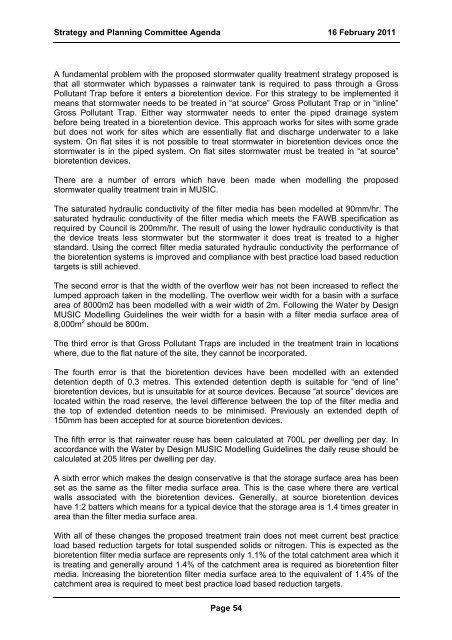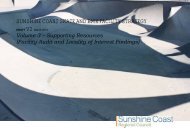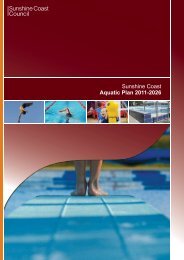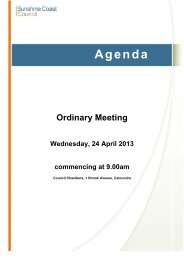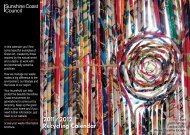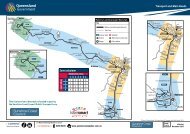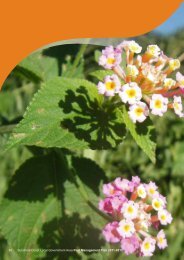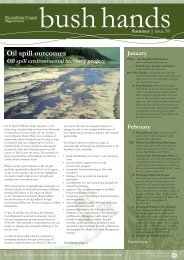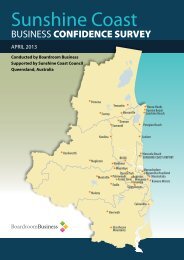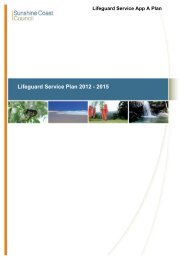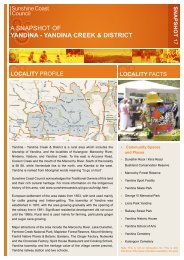AGENDA - Sunshine Coast Council
AGENDA - Sunshine Coast Council
AGENDA - Sunshine Coast Council
Create successful ePaper yourself
Turn your PDF publications into a flip-book with our unique Google optimized e-Paper software.
Strategy and Planning Committee Agenda 16 February 2011<br />
A fundamental problem with the proposed stormwater quality treatment strategy proposed is<br />
that all stormwater which bypasses a rainwater tank is required to pass through a Gross<br />
Pollutant Trap before it enters a bioretention device. For this strategy to be implemented it<br />
means that stormwater needs to be treated in “at source” Gross Pollutant Trap or in “inline”<br />
Gross Pollutant Trap. Either way stormwater needs to enter the piped drainage system<br />
before being treated in a bioretention device. This approach works for sites with some grade<br />
but does not work for sites which are essentially flat and discharge underwater to a lake<br />
system. On flat sites it is not possible to treat stormwater in bioretention devices once the<br />
stormwater is in the piped system. On flat sites stormwater must be treated in “at source”<br />
bioretention devices.<br />
There are a number of errors which have been made when modelling the proposed<br />
stormwater quality treatment train in MUSIC.<br />
The saturated hydraulic conductivity of the filter media has been modelled at 90mm/hr. The<br />
saturated hydraulic conductivity of the filter media which meets the FAWB specification as<br />
required by <strong>Council</strong> is 200mm/hr. The result of using the lower hydraulic conductivity is that<br />
the device treats less stormwater but the stormwater it does treat is treated to a higher<br />
standard. Using the correct filter media saturated hydraulic conductivity the performance of<br />
the bioretention systems is improved and compliance with best practice load based reduction<br />
targets is still achieved.<br />
The second error is that the width of the overflow weir has not been increased to reflect the<br />
lumped approach taken in the modelling. The overflow weir width for a basin with a surface<br />
area of 8000m2 has been modelled with a weir width of 2m. Following the Water by Design<br />
MUSIC Modelling Guidelines the weir width for a basin with a filter media surface area of<br />
8,000m 2 should be 800m.<br />
The third error is that Gross Pollutant Traps are included in the treatment train in locations<br />
where, due to the flat nature of the site, they cannot be incorporated.<br />
The fourth error is that the bioretention devices have been modelled with an extended<br />
detention depth of 0.3 metres. This extended detention depth is suitable for “end of line”<br />
bioretention devices, but is unsuitable for at source devices. Because “at source” devices are<br />
located within the road reserve, the level difference between the top of the filter media and<br />
the top of extended detention needs to be minimised. Previously an extended depth of<br />
150mm has been accepted for at source bioretention devices.<br />
The fifth error is that rainwater reuse has been calculated at 700L per dwelling per day. In<br />
accordance with the Water by Design MUSIC Modelling Guidelines the daily reuse should be<br />
calculated at 205 litres per dwelling per day.<br />
A sixth error which makes the design conservative is that the storage surface area has been<br />
set as the same as the filter media surface area. This is the case where there are vertical<br />
walls associated with the bioretention devices. Generally, at source bioretention devices<br />
have 1:2 batters which means for a typical device that the storage area is 1.4 times greater in<br />
area than the filter media surface area.<br />
With all of these changes the proposed treatment train does not meet current best practice<br />
load based reduction targets for total suspended solids or nitrogen. This is expected as the<br />
bioretention filter media surface are represents only 1.1% of the total catchment area which it<br />
is treating and generally around 1.4% of the catchment area is required as bioretention filter<br />
media. Increasing the bioretention filter media surface area to the equivalent of 1.4% of the<br />
catchment area is required to meet best practice load based reduction targets.<br />
Page 54


